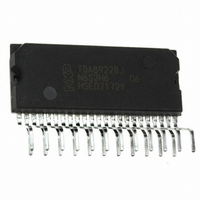TDA8920CJ/N1,112 NXP Semiconductors, TDA8920CJ/N1,112 Datasheet - Page 6

TDA8920CJ/N1,112
Manufacturer Part Number
TDA8920CJ/N1,112
Description
IC AMP AUDIO PWR 220W 23SIL
Manufacturer
NXP Semiconductors
Type
Class Dr
Datasheet
1.TDA8920CJN1112.pdf
(39 pages)
Specifications of TDA8920CJ/N1,112
Output Type
1-Channel (Mono) or 2-Channel (Stereo)
Package / Case
23-SIL (Bent and Staggered Leads)
Max Output Power X Channels @ Load
220W x 1 @ 8 Ohm; 125W x 2 @ 4 Ohm
Voltage - Supply
±12.5 V ~ 32.5 V
Features
Depop, Differential Inputs, Mute, Short-Circuit and Thermal Protection, Standby
Mounting Type
Through Hole
Product
Class-D
Output Power
210 W
Available Set Gain
36 dB
Common Mode Rejection Ratio (min)
75 dB
Thd Plus Noise
0.05 %
Maximum Operating Temperature
+ 85 C
Mounting Style
Through Hole
Audio Load Resistance
8 Ohms
Dual Supply Voltage
+/- 30 V
Input Signal Type
Differential
Minimum Operating Temperature
- 40 C
Output Signal Type
Differential, Single
Supply Type
Dual
Lead Free Status / RoHS Status
Lead free / RoHS Compliant
Other names
568-4784-5
935281808112
TDA8920CJ/N1
TDA8920CJ/N1,112
TDA8920CJ/N1
935281808112
TDA8920CJ/N1
TDA8920CJ/N1,112
TDA8920CJ/N1
NXP Semiconductors
TDA8920C_2
Product data sheet
The TDA8920C single-chip class-D amplifier contains high-power switches, drivers, timing
and handshaking between the power switches, along with some control logic. To ensure
maximum system robustness, an advanced protection strategy has been implemented to
provide overvoltage, overtemperature and overcurrent protection.
Each of the two audio channels contains a PWM modulator, an analog feedback loop and
a differential input stage. The TDA8920C also contains circuits common to both channels
such as the oscillator, all reference sources, the mode interface and a digital timing
manager.
The two independent amplifier channels feature high output power, high efficiency, low
distortion and low quiescent currents, and can be connected in the following
configurations:
The amplifier system can be switched to one of three operating modes using pin MODE:
A slowly rising voltage should be applied (e.g. via an RC network) to pin MODE to ensure
pop noise-free start-up. The bias-current setting of the (VI converter) input stages is
related to the voltage on the MODE pin.
In Mute mode, the bias-current setting of the VI converters is zero (VI converters are
disabled). In Operating mode, the bias current is at a maximum. The time constant
required to apply the DC output offset voltage gradually between Mute and Operating
mode levels can be generated using an RC network connected to pin MODE. An example
of a switching circuit for driving pin MODE is illustrated in
omitted, the very short switching time constant could result in audible pop noises being
generated at start-up (depending on the DC output offset voltage and loudspeaker used).
Fig 4.
•
•
•
•
•
Stereo Single-Ended (SE)
Mono Bridge-Tied Load (BTL)
Standby mode: featuring very low quiescent current
Mute mode: the amplifier is operational but the audio signal at the output is
suppressed by disabling the voltage-to-current (VI) converter input stages
Operating mode: the amplifier is fully operational, de-muted and can deliver an output
signal
Example of mode selection circuit
operating
Rev. 02 — 11 June 2009
mute/
5.6 k
5.6 k
+ 5 V
S1
10 F
operating
standby/
470
2
S2
110 W class-D power amplifier
Figure
mode control
SGND
010aaa552
4. If the capacitor was
TDA8920C
© NXP B.V. 2009. All rights reserved.
6 of 39















